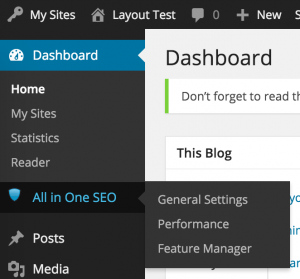SEO in WordPress
WordPress is very good at Search Engine Optimisation (SEO). You don’t need to do anything if you don’t want to. WordPress automatically creates post titles, URLs, tagging and categories, which lend themselves very well to being discovered by search engines.
If you really want to tune your site for particular needs, we can, on request, enable further options via a plugin called All in One SEO which offers a number of options to enhance your sites’ performance in search engines. It’s not an simple plugin, so you need to be sure you have the time and will to use it properly. SEO is a complex area, and search engines such as Google constantly adjust their algorithms, you’ll need to put some time in if you want to see results.
Using All in One SEO
If all you do is activate the plugin, you will still see some benefits, but if you want to go deeper, check out the SEO General Settings screen in your Dashboard.

The first panel deals with Canonical URL support. Canonical URLs are just a way of avoiding duplication in Search Engine indexes. If the same page content appears in several locations, a canonical URL can help a search engine work out which one is the original (and most important) source. If a search engine is unclear about duplicated content, it may lead to users seeing annoying duplicated results, and most search engines will penalise your ranking for such duplication. The default settings are fine, you shouldn’t need to change these.
The next few panels in the General Settings allow you to override, or change the way important parts of the page are represented. The main aim is to ensure that words that are important to your site and pages are well represented. If your content is well written, most of these fields won’t need to be changed. Tweaking these settings can make a small difference, but before doing so, you should understand about keyword density and repetition. Not enough, and it won’t have an effect, too much, and you risk having your site seen as ‘spammy’ and penalised as a result.
One option that might be useful for some sites, is the ability to add codes that associate your site with to your Google, or Bing accounts.
Noindex settings are another good option to prevent indexing of listing pages on your site. This avoids pages like blogs.unimelb.edu.au/mysite/page/5/ turning up in searches, with the benefit that users find the real pages more easily, because there’s less clutter in search results.
More features
You’ll also have access to a number of Features which you can enable and disable. Most of these are designed for self managed WordPress sites, where you have access to the server. We don’t have the required access, so you will not be able to use: XML Sitemaps; Robots.txt; or File Editor. We don’t recommend using the Bad Bot Blocker unless you really know what you’re doing.
That leaves one ‘Feature’, that we do recommend using, and it does a pretty good job! The Social Meta tool, creates a number of special tags which help social media sites display more attractive links to your page. You don’t need to configure it, just enabling it will help, but if you know what you’re doing, it can really enhance the way your site appears in social media.